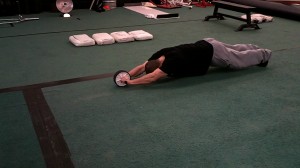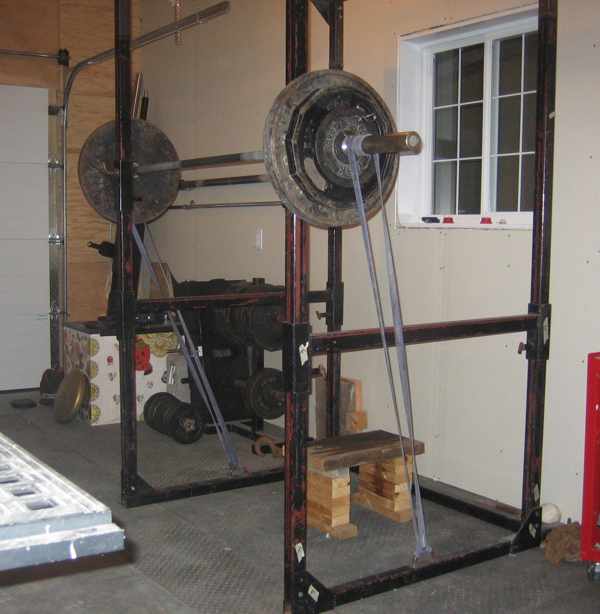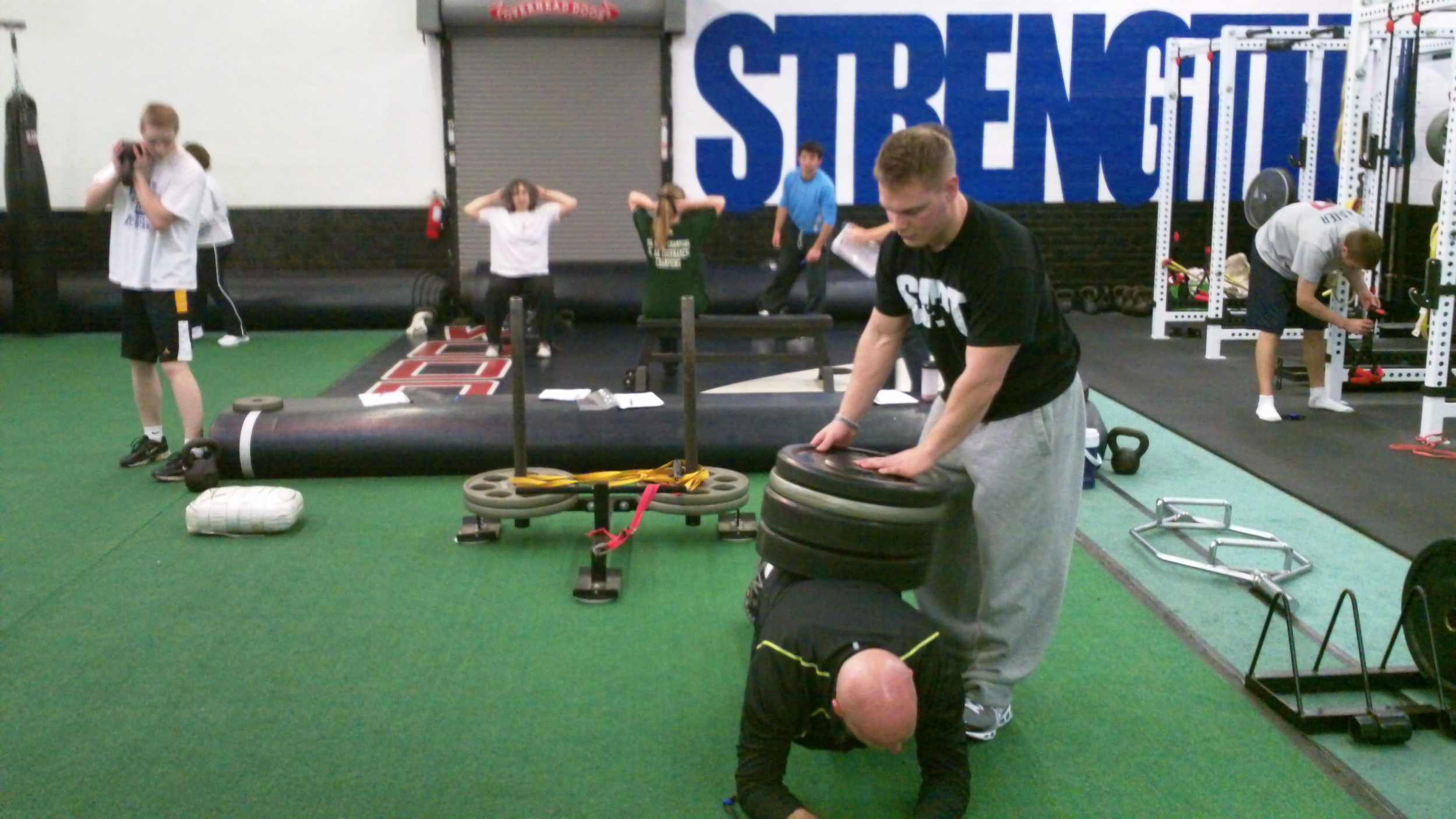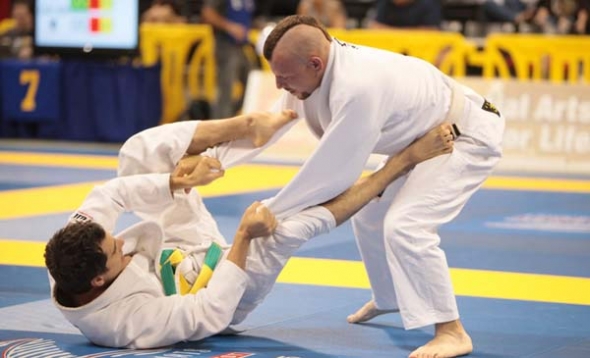The Yo-Yo Intermittent Recovery Test
Whether you call it the Beep, Bleep, or Yo-Yo Test all the names are all essentially synonymous. Jens Bangsbo, a Danish soccer physiologist, developed the beep test in the early 90’s. It is wildly popular with soccer teams worldwide, but has applications for all sports of intermittent nature.
 Who the Beep Test is for:
Who the Beep Test is for:
Well in this case I am referring to one specific variation of the beep test: the Yo-Yo Intermittent Recovery Test (Yo-Yo IR1 or 2). This assessment is fantastic for team sports of an intermittent nature (meaning there’s a lot of stop-and-go). I use it with my basketball, lacrosse, and soccer teams. It would also be appropriate for rugby.
***Disclaimer: This is a MAXIMAL effort test and should only be conducted with competitive athletes, not recreational athletes. There is a high level of fitness needed to successfully complete testing.
Why this test is so great:
- It is SUPER easy to implement in a team environment! You don’t need any special equipment; just some cones, measuring tape, whistle, and an app that plays the test version you want (the one I use cost about $3).
- It allows a coach to know an athlete’s VO2max for comparison and progress tracking purposes without having to use any fancy-schmancy equipment.
- The Intermittent Beep Test is a fairly sport-specific test for the team sports I listed above. It accounts for the frequent sprints, cuts, and walking associated with such sports and allows us coaches to apply a structure for analysis. This test goes light-years beyond simply running the mile in terms of the relevance of information that can be extracted.

Setup & Protocol:
- Create lanes for each athlete to run within – a lane is comprised of 3 cones. From where you place cone 1, measure out 5 meters and drop the second cone, from cone 2, measure out 20 meters and drop the third cone. Repeat this process for the number of lanes you need.

- Be certain to go over the rules of the Beep Test thoroughly with the athletes ahead of time. The speed increases as the test progresses and sometimes that’s hard for them to grasp. I usually let the group do a few passes as practice to remember what the test feels and sounds like.
- Start the test! If you are using this with a large team, you’ll want to divide the group in half and run it in two flights. This way, the athletes can partner up and the non-running athlete can count the total number of sprints for the runner.
- Two “misses” end the test. Record the total number of sprints.
***The purpose of reviewing test structure is simply to give you an idea of how the Beep Test is conducted. Consult formal instructions that come with the recording/app for more detailed information.
Interpretation:
Once you’ve recorded the results, now you want to know what it means! Simply plug your results into one of these two formulas to get the VO2max estimation:
Yo-Yo IR1 test:VO2max (mL/min/kg) = IR1 distance (m) × 0.0084 + 36.4
Yo-Yo IR2 test: VO2max (mL/min/kg) = IR2 distance (m) × 0.0136 + 45.3
Now that you know where your athletes' VO2max scores fall, you can begin to track and compare across other sporting platforms and look vertically within your sport at different levels to see where your athletes fall.
 As a side note, I think this is the first post I've gotten up on-time in about a month (10am is the soft-deadline). I've already patted myself on the back.
As a side note, I think this is the first post I've gotten up on-time in about a month (10am is the soft-deadline). I've already patted myself on the back.
A Small Favor to Ask
Not gonna lie, I'm fairly swamped this morning. With 19 training programs to whip up, along with responding to the usual bank of emails and attending to operational needs - on top of ensuring I make it into the gym in time to keep Ryan from hurting himself - I'm in a bit of a time crunch. That being said, I have time for just a small favor to ask. Can you all please, pretty please (with a cherry on top), "Like" SAPT on Facebook?
 Click Me ==> "Like" SAPT <== Click Me
Click Me ==> "Like" SAPT <== Click Me
If you enjoy reading the information we put out, and/or have benefited in any way from our posts, we would really appreciate it. We really do put a lot of time and effort into handing out quality stuff to our readers, and this way we can help you stay in the loop of when we put new stuff out there; not just blog posts, but free distance training offers, clothing give-aways, and the like.
I'll be honest, I used to think the whole "Like-ing" thing was ridiculous. Heck, I'm embarrassed to admit it but only six months ago I didn't even know what the term "social media" referred to when Ryan first threw that strange word at me. Yeah, I'm that hip. That "with" the current trends, if you will.
However, I've realized that, for me personally, it has given me a method of supporting - at least in a small way - groups that I've learned something and/or bettered myself from. Given that I've never pushed SAPT's social media on here before (we're new to it as a business ourselves), I thought it'd be worth a shot with you all.
Soooo, please click HERE to give us some lovin'! All the cool kids are doin' it.
5 Quick & Random Training Tips
1. How and when you do your abdominal training in a given week is actually fairly important. For example, if you decide to do standing rollouts 24-48 hours before a heavy deadlift session, chances are your deadlifts are going to suffer greatly, and perhaps even be risky to attempt (it will be much more difficult to stabilize your lumbar spine).
 This is because rollout variations place incredible eccentric stress on the anterior core, inducing large amounts of soreness and requiring a longer recovery period. The only caveat to this rule would be if your name is Ross Enamait.
This is because rollout variations place incredible eccentric stress on the anterior core, inducing large amounts of soreness and requiring a longer recovery period. The only caveat to this rule would be if your name is Ross Enamait.
Other abdominal programming faux pas I can think of would be pairing an anterior loaded barbell variation (i.e. front squat or zercher grips) with an ab exercise, and/or placing a hanging leg raise before or alongside a farmers walk. The former is a blunder because anteriorly loaded barbell movements already place considerable demands on the core musculature; the latter isn't the greatest idea because your grip endurance is going to become an issue. Spread them apart to receive the maximum benefit of each.
2. If squatting is problematic for you, you don't need to force it. At least not initially. While the squat is a phenomenal movement and undoubtedly should be a staple in one's strength and conditioning program, I'm finding that more and more people need to earn the right to back squat safely, much like the overhead press. This may be due to structural changes (i.e. femoroacetabular impingement) or immobility (i.e. poor hip flexion ROM or awful glenohumeral external rotation and abduction).
If this is the case, simply performing a heavy single-leg movement as the first exercise in the session will work perfectly. You can use anything from forward lunges to bulgarian split squats, but my favorite is probably the barbell stepback lunge with a front squat grip.
You're still receiving the benefits of axial loading due to the bar position, you can still receive a healthy dose of compressive stress in your weekly training (if you're deadlifting), and yes, you'll still be exerting yourself. I recommend performing these in the 3-6 rep range to allow for appreciable loads.
And, keep in mind, when I said "if squatting is problematic" at the beginning of point #2, I was referring to structural, mobility, and/or stability abnormalities that may make it unsafe for you to squat for the time being. I wasn't, of course, implying that if it's "just too hard" that you shouldn't do it. There's a pretty thick line between one being contraindicated for an exercise and someone who's simply unwilling to to do a lift because it takes mental+physical exertion.
3. If your wrists bother you while doing pushups, try holding on to dumbbells. It will take your wrist out of an extended position into more of a neutral one, greatly reducing the stress on that joint.
 I also like holding on to dumbbells because they allow you to use a "neutral grip," thus externally rotating the humerus, giving your shoulder more room to breathe.
I also like holding on to dumbbells because they allow you to use a "neutral grip," thus externally rotating the humerus, giving your shoulder more room to breathe.
4. Think twice before consuming dairy as your pre-workout fuel. This may seem obvious, but frankly I still talk to people who consume cereal before a morning workout, or down milk shortly before an evening training session. Your stomach isn't going to like this while doing chest-supported T-Bar rows, anti-extension core variations, or anything for that matter.
Another tip: don't shove a bunch of doughnuts down your pie hole before training. I thought this one would be no-brainer, but I actually had a kid vomit after pushing the prowler at a sub-maximal intensity. Upon asking him what he ate beforehand, he said, "Umm, well nothing all day, and then I ate a bunch of doughnuts before coming here." Fail.
5. Figure out for yourself what training split is best for you personally. For example, I feel that training upper body the day before lower body affects me (negatively) more than if I do it the other way around. However, I know others who feel the exact opposite. Also, for those of you who utilize a bodypart split, and train deadlifts on "back day," be sure to take into consideration when and how you'll do squats on "leg day," due to the beating your spine will receive from both exercises.
New Website, New Coach - New Ideas All Around!
I've got a couple awesome announcements:
- For awhile now I've wanted to have a sister website to SAPTstrength.com. Over the years, I've noticed all the quality training related sites tend to be male-centric. Even at SAPTstrength.com, our readership is vastly male. For the few sites dedicated to females, I feel there is something left to be desired. There seem to be two camps of female driven training sites - the ones that are used as personal diaries of sorts and the ones that... how can I say this delicately... end up being male-centric due to the nature of some of the posts. Now there is nothing wrong with putting up a personal diary of your accomplishments and struggles. In fact, I think this is fantastic and will provide motivation to numerous individuals who can relate. There's also nothing wrong with "strutting your stuff" via photo or video, but let's face it... that doesn't exactly scream PROFESSIONALISM, does it? So, my goal with this sister site: StrongGirlsWin.com is to provide quality information by professional strength coaches presented in a professional manner for the female training population. Please check us out and spread the word to your daughters, wives, girlfriends, and awesome females of all walks of life via Facebook, Twitter, email, text, or messenger pigeon. I appreciate our readership's support every single day and know you'll support us in the effort to enhance the female training conversation!
- What's the tipping point on getting this new site up and running? Well, it just happens to be SAPT has now been fortified with another crazy strong, crazy awesome female coach. Her name is Kelsey Reed and, yes, she does happen to be recently married to the famous Stevo Reed. Check out her bio and be sure to check out her upcoming blog entries for both StrongGirlsWin.com and SAPTstrength.com!
Which mass-gaining method is "best"?
After dragging my brain through 41 pages of research on "The Influence of Frequency, Intensity, Volume and Mode of Strength Training on Whole Muscle Cross-Sectional Area in Humans" guess what the conclusion was on an extensive study designed to figure out the best way/combination of ways to increase muscle mass? Essentially, that all variables are valuable and there is NO ONE SINGLE MAGIC BULLET.
Sometimes - okay, a lot of times - research totally cracks me up. I think I've stated this before. This paper was about 10x longer than most with extreme detail and for what... to confirm something that any experienced strength coach knows:
Regarding progression, we recommend low volumes (e.g. 1–2 sets) in the initial stages of training, when performing eccentric-muscle actions, because low volumes have been shown to be sufficient to induce hypertrophy in the early stages of training and because exercise adherence may be improved if the workout is relatively brief. Also, avoiding unnecessary damage may allow hypertrophy to take place earlier. As the individual adapts to the stimulus of strength training, the overall volume and/or intensity may have to be gradually increased to result in continued physiological adaptations and other strategies (e.g, periodisation) can also be introduced if even further progress is desired.
So, through actual published research (and not the usual anecdotal evidence), it is confirmed that the best policy when progressing an individual for anything - in this case hypertrophy - is always found in moderation.
The next time you're considering ordering any number of TV products promising to solve all your problems or thinking about signing your kid up for training that "guarantees" quick results, I ask that you keep in mind some solid research and accept that anything worthwhile in life takes time, hard work, and guidance.
SAPT Exercise of the Week: Turtle Rolls for the Anterior Core
Ever since Dr. Stuart McGill (professor of spine biomechanics at the University of Waterloo) unleashed his research on spinal health and published his book, Ultimate Back Fitness and Disorders, the fitness industry was awakened to the fact that the typical human sit-up places up to 3,300N of compressive force on the lumbar spine. For those who are wondering if this is a good thing: it's not. As such, when it comes to enhancing someone's "core" strength, I'm almost always going nix repeated spinal flexion in training (i.e. sit-ups), and opt for improving spinal stability. Think pallof presses, landmines, woodchops, single-arm farmers walks, and planks, to name a few.
Or, I may choose a host of anti-extension exercises to give someone their ab training fix, utilizing any of the 20+ demonstrations I give in the video below:
However, should ALL movements resembling a sit-up be avoided like the bubonic plague? I don't think so.
While I do believe that - nine times out of ten - one should train spinal stability in order to correct low back dysfunction, reduce the risk of injury, and morph into a healthy, high-functioning athlete; there are exceptions to the rule.
For example, if I'm training a number of mixed martial artists (which we're consistently doing at SAPT), are you telling me that I never need to help them improve their abdominal strength for guarding?
Or, if helping someone prepare for a military test, should I avoid having them do sit-ups even though the testing protocol calls for a very specific test in sit-up endurance?
(Disclaimer: What I am NOT saying is that you always need to train people in positions specific to where they find themselves in sport (Ex. If I'm training a boxer do I need to repeatedly punch him in the face?). However, sometimes a small dose of a particular training protocol is needed to maximally prepare someone for their respective event.)
Turtle Rolls
Enter the turtle roll. This is a brutal abdominal exercise that hammers the rectus abdominus, along with the internal and external obliques, to both maintain trunk flexion and resist trunk extension. See the demo below:
How to do it:
- Wrap your hands behind your head and touch your elbows to your knees
- Have a partner SLOWLY rock you up and down, touching your heels to the ground at the top
- Brace your abs HARD. Try not to generate any momentum to "swing" yourself up
- Perform 8-12 repetitions
- A cat walking around you is optional
The beauty of these is that you can do them virtually anywhere, as long as another person is close at hand. It is much harder than it looks to keep your elbows in contact with your knees, especially if your partner is moving you slowly. After you master a bodyweight turtle roll, you can hold a weight plate on top of your head (you won't need much though, trust me).
A couple caveats:
- If you have back pain, I'd avoid this one. You can receive plenty of good ab training via other means
- If adding turtle rolls in a training cycle, be sure to do plenty of work for the erectors and include a healthy dose of thoracic mobility drills to prevent hyperkyphotic postural adaptations in the thoracic spine. You should be doing this anyway, though....GOSH!!
- Don't get too addicted to these. They'll certainly fill your "I need to feel my abs burn" craving but be careful to keep your total volume of spinal flexion work in check
That's it, try it out and let me know what you think.









